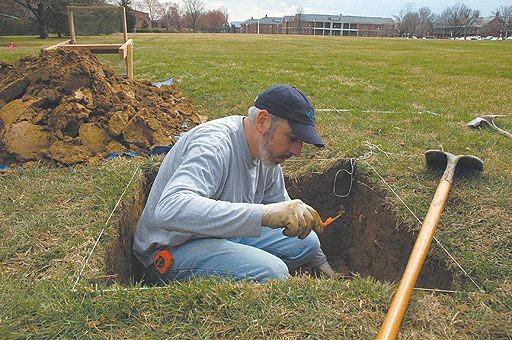
Kim Holien, Joint Base Myer-Henderson Hall historian, met March 16 with three JBM-HH Directorate of Public Works employees, Dave Metzger, DPW contracting officers representative for ground, Kristie Lalire, JBM-HH Directorate of Environmental Management cultural resource program manager and Mackenzie Rohm and Chris Bowen, Versar Corporation archaeologists.
For Holien, the continuation of the DEM-sponsored archeological investigation on Summerall Field brought renewed hope of unearthing a buried Civil War cannon.
''Today I hope we find the pot of gold at the end of the rainbow," Holien said as he walked toward the ceremonial field that morning, carrying a Happy St. Patrick's Day sign, painted with the familiar good luck symbols.
Rohm and Bowen spent most of the day digging up one of four areas where a ground-penetrating radar had depicted anomalies under the ground during their initial study of Summerall Field in December 2010.
The archaeologist surveyed and dug a 30x30 inch test hole about 20 inches down. This was considered a very promising radar return on the GPS used to sweep Summerall Field to look for the possible presence of a Civil War cannon last December, Holien said.
''They located an underground locked drainage system about two feet down, but no cannon," said Holien.
''At this time no one knows when the drainage system was built."
''It was located just below the 69 caliber mini ball Civil War bullet they found while digging. It was a dropped bullet and had never been fired," he said.
Finding the bullet would indicate [the era] 1861 to 1865, Holien said.
''There was nothing there from 1861 to 1865 that we know about," Holien said.
''Prior to the Civil War, this area was a huge virgin Oak forest and everything was eventually clear-cut during the Civil War for the troop usage of large quantities of wood."
In 1981 or 1982 when he first started working at Fort Myer, he was assigned to a team to dig and build a cement staircase going from the swimming pool behind the Officers' Club down a steep slope and leading to a location where Bldg. 205 is now located, Metzger said.
''We came across three Civil War cannons in that area and were told there were about 100 Civil War cannon balls there, although I did not see them," Metzger said.
Holien said Metzger told him these artifacts were turned over to the 3rd U.S. Infantry museum.
''I spoke to the current and previous museum staff, who informed me no records were available from 1981 to 1982 to indicate if any cannons or cannon balls were located," Holien said.
''I also talked to Less Jensen at the West Point Museum - the first professional museum curator to come to the 3rd U.S. Infantry museum in 1987," said Holien.
''[Jensen] said records were sporadic. The workers who had been here in 1981-82 were long gone, and there was no memory about cannons or cannon balls located here at Fort Myer."
''In 1970, 10 or 12 large 25 pound Shackle Civil War artillery shells were located where Fort Worth was on the west side of Alexandria, Va.," Holien said.
''These were dug up by the contractor developing the Fort Worth site near Alexandria Hospital. They were turned over to Fort Ward, which is a city park commemorating one of the Civil War forts surrounding Washington, D.C. Fort Ward sent them down to Fort Belvoir for disarmament and three of the shells were returned to Fort Ward for display purposes," he said.
This information shows us when Civil War artillery shells and cannon balls were located in the Washington metro area.
They routinely went down to the EON at Fort Belvoir, which was the headquarters of the Army engineers at that time. They would be disarmed or detonated, Holien said.
''After discussing everything with Daniel Hayes [geoarchaeologist from Charlottesville, Va.] and G. William Monaghan, [geoarchaeologist and interim director of Glenn A. Black Laboratory of Archaeology, Indiana University, Bloomington], co-owners of Hayes and Monaghan Geoarchaeologists, contracted with Versar, who did the initial ground-penetrating radar study at Summerall Field," Rohm said.
''We feel there might be a deviation or variable factors from the area we investigated there."
''Based on Monaghan and Hayes interpretation of the GPS survey, they don't think we hit the higher up anomaly," Rohm said.
There were four strong undetermined objects located at about 30 to 40 centimeters below ground discovered during the GPS survey, Rohm said.
''We never hit anything at that depth so it was interpreted as the drain being deeper in reality than depicted in the GPS."
Their report will give a detailed recommendation of what should be done in the future.
''Perhaps we can do another study next fall after the ceremonial season on Summerall Field," Rohm said.

Social Sharing